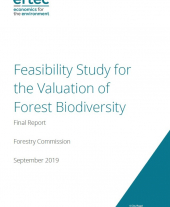Assessing the Cost-effectiveness of Woodlands in the Abatement of Carbon Dioxide Emissions

This study assesses the cost-effectiveness of a range of woodland types across England, Scotland and Wales in removing carbon dioxide from the atmosphere. The study uses two measures of cost-effectiveness: a physical measure (cost per tonne of CO2 removed) and a value measure (comparing the cost against the value of the CO2 removed). The study develops a "marginal abatement cost curve" which shows how much CO2 removal can be achieved through planting new woodlands for a given cost. Cost-effectiveness is considered over two time horizons: first, to 2050 and, second, to 2200. The analysis takes account of the benefits of storing carbon in wood products and of substituting wood for more carbon-intensive product and fuels.
It concentrates on the impact of additional new woodland and does not consider changes to the management of existing woodlands.
File Name
CJC_cost_effectiveness_15.pdf
Category
File Size
624.94 KB
File Type
application/pdf
Version
2


